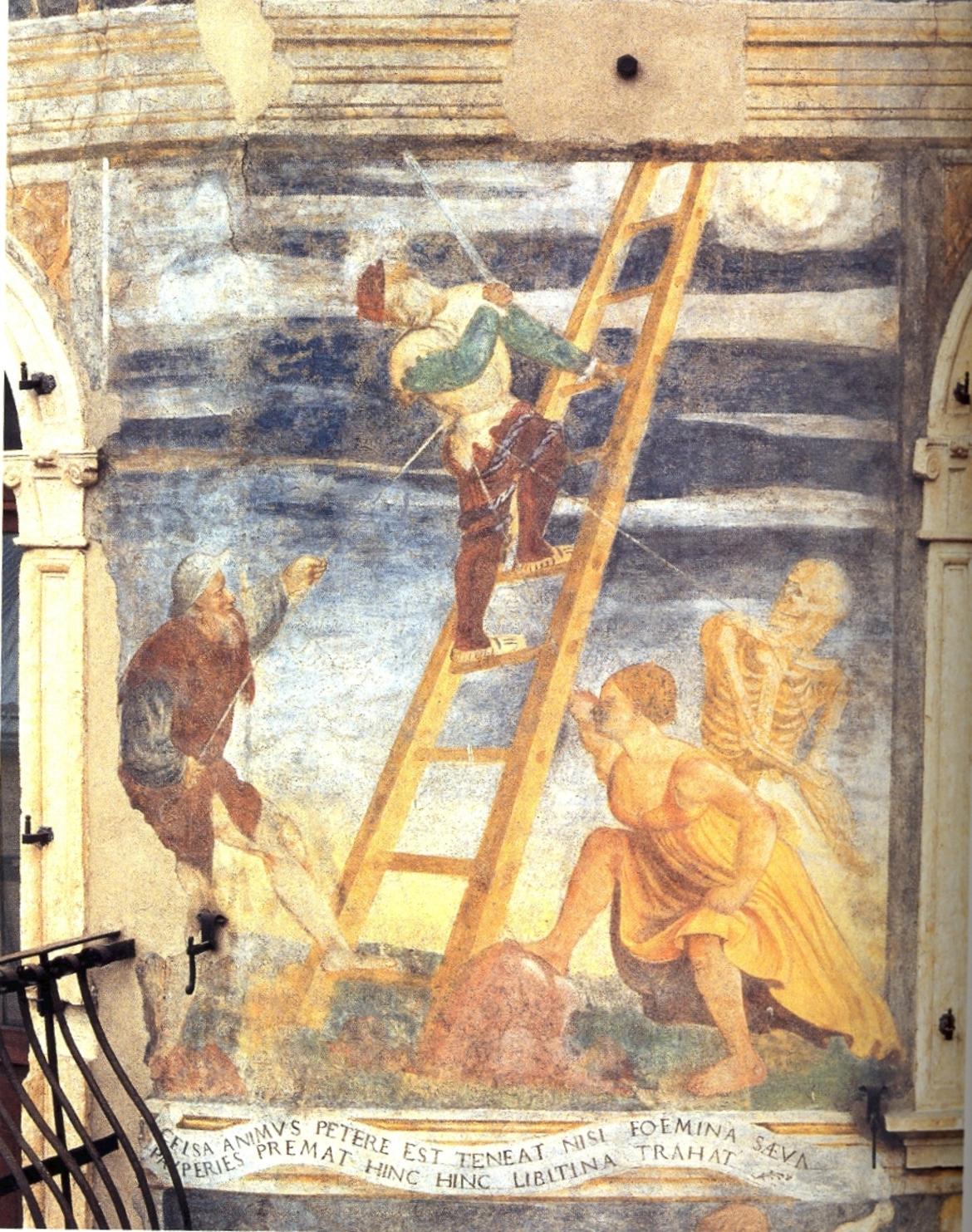A warning which is as relevant as ever
The ladder as symbol of a possible spiritual ascent, but also of its opposite

The well-known painted façade of one of the two houses overlooking the old town square of Trento, next to the Cathedral of S. Vigilio, displays an iconographic programme with a complex meaning.
It’s an intricate context, but if you peruse a portion of it, you’ll detect a young man who shows off a rich costume and feathered hat while climbing a ladder raised to the sky; though, he is held back by three people who are tightening some ropes tied to his waist in the effort of holding him down to the ground.
The young man reacts brandishing his sword to sever the ropes held by the three characters, who respectively symbolize Lust, represented by a young woman with a large neckline; Poverty, represented by a shabby bearded man; Libitina, that is Death, represented by a skeleton.
A Latin inscription reminds us that "The human soul would aim for higher things, if the cruel woman didn’t hold him back, if Poverty didn’t oppress him, and if, on the other hand, Libitina – that is death – didn’t draw him to herself."
The immediate precedent of this fresco Trentino is a small number of engravings of the early decades of the sixteenth century, which represent the ancient idea of the Christian who fights against the world’s evils to attain to the salvation of his soul.
What’s more, a famous quote from Cicero's De officiis was probably an influence in the fresco of Trento: "those are to be admired, who ... are free of any shameful stain and of those vices which most people can hardly resist. Pleasures, in fact, are like flattering masters that divert our souls from virtue, and when pain becomes sharper, the majority of us are frightened beyond measure. Life, death, wealth and poverty trouble us deeply." (I Doveri, - i.e. Duties -, lib. II, 37). Thererfore, unlike the Christian ascetic ideals, in the humanistic thought reflected in this fresco and based on writers of the past, Poverty is a fearful enemy of the young man who wants to rise spiritually, since it leads to the margins of social life; it causes ugliness and is an obstacle to both the body and the spirit; it also prevents people from emerging socially, even if they have the skills needed.
The ladder is therefore a symbol of a possible spiritual ascent, but is also a symbol of the opposite of it, namely the possibility of a progressive descent - if man isn’t resolute enough -, or even of an eventual ruinous downfall. The use of free will is the necessary condition for both a positive and a negative outcome.
Further reading:
Laura Dal Pra, L’elevazione spirituale dell’individuo tra etica umanistica e morale cristiana (The spiritual ascent of man between humanistic ethics and Christian morality).
Il miles christianus e la scala coeli in un affresco della Trento rinascimentale, in L’Officina dell’arte. Esperienze della Soprintendenza per i Beni Storico-artistici, a cura di L. Giacomelli – E. Mich, Trento 2007 (“Beni Artistici e Storici del Trentino. Quaderni”, 13), pp. 93-113.
(The miles christianus and the scala coeli in a fresco of Renaissance Trento, in The Art workshop. Experiences of the Department responsible for history and artistic heritage, archival and library material, edited by L. Giacomelli - E. Mich, Trento 2007 - "Artistic and Historical Heritage of Trentino. Notebooks", 13, pp. 93/113).
01/12/2014

